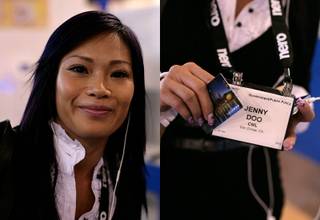
Show attendees browse the different booths in the Las Vegas Convention Center during the Consumer Electronics Show in Las Vegas on Saturday.
Sunday, Jan. 11, 2009 | 2:10 a.m.
Expanded coverage
Sun archives
Beyond the Sun
For the past 11 years, Wired magazine has been publishing its annual Vaporware Awards, a "roundup of the tech industry's biggest, brashest and most baffling unfulfilled promises."
The Consumer Electronics Show seemed like the perfect opportunity for these companies to prove their product existed -- to show everyone that it was tangible, rather than something more akin to a perpetual-motion machine.
Instead, for the five products on Wired's list that weren't software, the best their companies could offer in their own defense were new, similar but different products or, in most cases, a half-hearted "we're working on it."
Of course, that was for the companies that even bothered to show up. Two of them were nowhere to be seen at CES:
• Myka: The No. 9 product on Wired's list thrilled the software pirates in March when the company announced a set-top box that featured HDMI connections, top-of-the-line video codec support, a 160GB hard drive and a built-in torrent program — a combination that might make a cable box obsolete (assuming you didn't mind catching an episode or two of your favorite shows a day late, once they had downloaded). However, while the company's Web site still allows preorders and makes it seem like the product is mere minutes away from being shipped, the site's forums tell a different story. As Wired noted, there's so much spam in them that your chance of finding anything out about when the product actually will launch is about as likely as it actually launching.
• Zap: An all-electric SUV that travels up to 155 mph, can go from 350 miles (basically from Las Vegas to San Diego) without needing to recharge, and — when it does need a pick-me-up — recharges in "as little as 10 minutes." That was the pitch for Wired's No. 7 disappointment: the Zap-X, a collaboration with Lotus Engineering that was originally scheduled to be on the market last year. The Zap Web site says the vehicle is "coming soon" while Wired says 2010, but without a representative at the show, it was impossible to determine if soon meant the beginning of the next decade or the beginning of the next century.
Which company came closest to living up to its previous promises? It's a tough call, but thanks to actually having a demonstration product on hand and a scheduled release date, the nearest thing to a winner was Microvision.
The company scored a lot of buzz at last year's convention for its PicoP projector. The tiny device connected to or was embedded in various mobile devices and could project DVD-quality images at any angle, on any surface and at nearly any size. It seemed like just the thing to impress all the suits who are used to dealing with full-sized projectors while giving PowerPoint presentations. A projector that fits in the breast pocket of your jacket seemed too good to be true.
For Microvision last year, it was. However, a number of other companies — including Toshiba and Optoma — released their own version of the product.
This year, Microvision returned to CES with the updated SHOW WX, which uses the PicoP display engine. Just slightly smaller than an iPhone, the device is scheduled for release in the second quarter of 2009 for between $400 and $500.
The other two remaining products — Garmin's nüvifone (No. 5) and an Android phone not made by T-Mobile's G1 (No. 3) — suffered from nearly the same fate: no one could talk about them.
Garmin representatives said they had no updates on the nüvifone (most recently scheduled for a first- or second-quarter launch this year), a device that combines a smartphone and a high-quality GPS unit, and didn't seem too thrilled to have the topic brought up in the first place.
The company also had no announcements on any other open-source handheld devices, pretty much matching the other seven manufacturers who are part of the Open Handset Alliance in terms of legitimate updates:
— HTC didn't have a booth;
— ASUSTeK no longer serves the U.S. market when it comes to phones;
— LG said it expected to have a product launched in the first half of 2009 in the rest of the world, with the United States to follow;
— Toshiba said it already had a global version available, but wasn't working on anything domestically;
— Stephen Sneeden, Sony Ericsson's national product training manager for marketing, would neither confirm nor deny the company was working on anything, saying only "it's one of those 'If I told you, I'd have to kill you' things."
— Motorola's PR people were tight-lipped, asking if their answers were being recorded before responding with a quick note (that stunk of rote memorization and practice) that something would be ready by the end of the year.
Surprisingly, the only other company that would come out and say they had anything in the works for the U.S. market was Huawei, a China-based telecommunications group. They said they would have an Android phone launch in the third quarter of this year, but wouldn't have an example of it until the GSMA Conference next month in Barcelona.
So, if you haven't read an article or a blog post about this as-yet-unnamed phone by the end of February, don't be surprised to see it — and its brethren — back on Wired's list next year.



Join the Discussion:
Check this out for a full explanation of our conversion to the LiveFyre commenting system and instructions on how to sign up for an account.
Full comments policy